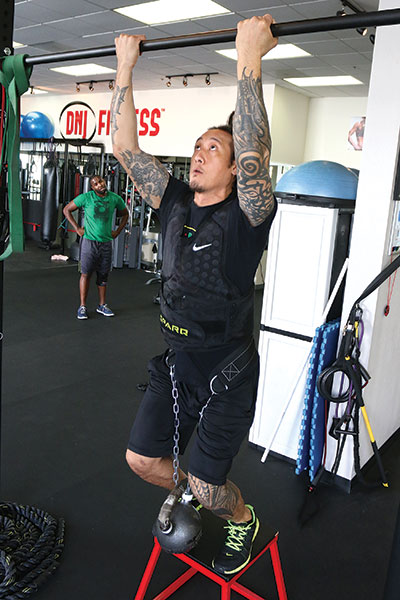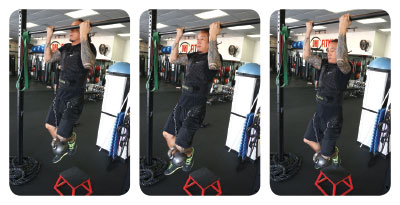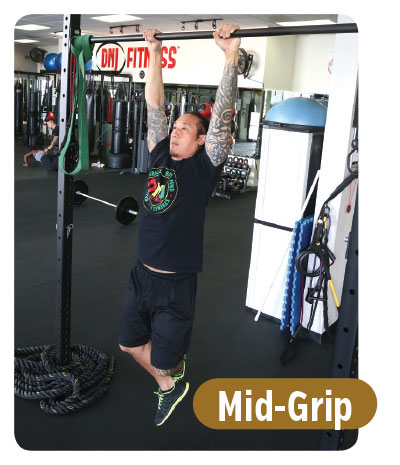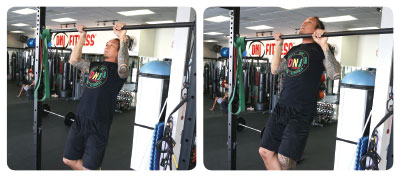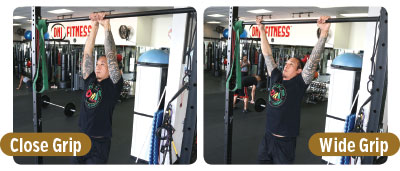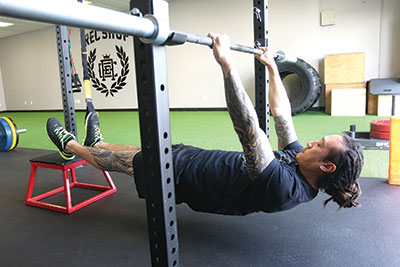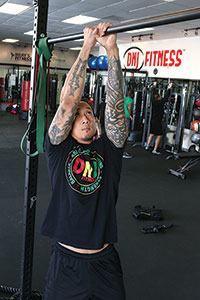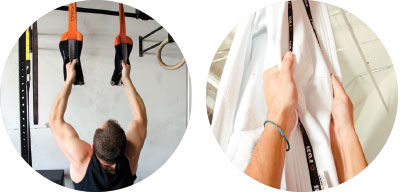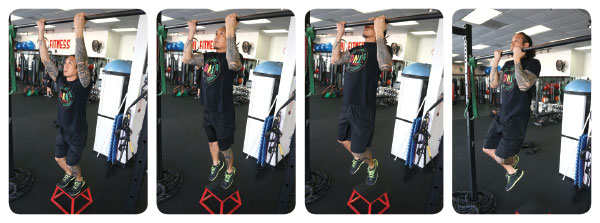Pull-up Power!
If for any reason you’ve missed the theme of our past two issues, we’re on a big calisthenics kick right now. We’ve shown you how to push-up your game and improve your core performance through planks, but now it’s time to raise yourself up and go above the bar (both literally and figuratively) with pull-ups.
“I HAVE THE POOWWEERR!!”
While the push-up may be old faithful, pull-ups and chin-ups are where it’s at if you want some real “HE-MAN” upper body power from a calisthenic exercise; with the exception of a planche push-up. For starters, our backs have much more muscle tissue than our chests do and since you’re continually raising and lowering your entire body weight, as compared to your feet being used like an anchor with a push-up, the movement is more taxing, but also yields greater results overall.
Muscles Involved
Pull-ups and chin-ups are compound exercises that require use of a variety of muscles, including the bicep brachii, brachialis, brachioradialis, latissimus dorsi (lats), teres major, posterior deltoid muscles, lower trapezius, pectoralis major and minor, triceps brachii, levator scapulae, rhomboid, and pretty much all of your core/trunk muscles, to be performed. As you can imagine, that’s a lot of internal movement going on underneath the skin, but the more recruitment of muscle fibers the better.
How Does That Transfer To Jiu-Jitsu?
How many times have you heard, “Posture up!” from your coach or seen a guy get smashed by a sprawl even though he had a grip on the legs? Performing pull-ups/chin-ups consistently will help you gain strength in your back to better deal with those situations. Another example is when you arm or leg drag an opponent. You are pulling them using the same mechanics as these exercises. They also inadvertently force your grip to improve because you must be able to hold up and move your body weight. I’m sure we all know how a strong grip can help or hinder us, dependent upon who’s applying it.
No Excuses
You don’t have a gym pass? So what! Pull-up/chin-up stands are available for your home. Still too expensive? Look into a doorway bar; there are removable models or ones that you can anchor to the frame. These will, however, limit you to perform more advanced movements because of factors, such as height and surroundings, but they still work great. Now if those are still too expensive or you don’t like them, I recommend taking a page out of the creator of Movnat, Erwan Le Corre’s playbook and find something to do it on. The side of the monkey bars at a local playground or even a large, steady tree branch will suffice. Movnat is a workout program that relies on use of our environment and bodyweight training. In order to do these types of exercises, you must perform them on an immovable object (or at the very least stationary) that will not break due to your bodyweight being suspended from it.
The Broken Record
Incase I haven’t drilled it in your head enough over the last two issues, here’s why calisthenics are so great again!
• Challenging exercise
• Little or no equipment needed
• Can be done almost anywhere
• Increases in strength and flexibility
• Improves balance, coordination, agility, muscular and cardiovascular fitness
It’s Okay To Be Negative
Maybe you despise pull-ups/chin-ups because you can’t lift your weight up; on the other hand, maybe you can power out an endless amount of them with no problem, so they don’t seem to be much of a challenge. Regardless of your circumstance, being negative about it can actually be positive. Negative (eccentric) training is the lowering part of any exercise and in contrast to the positive (concentric) portion we are all stronger during it. You may not be able to pull yourself up, but you can lower yourself. If you’re the heavy rep guy you can add a lot of weight using a variety of tools. Using negative training yields a ton of strength gains if used properly; however, it can’t be done too often because it’s so taxing on the body, so you want to focus on lower rep counts of higher quality.
1. Place a stationary object (bench, stool, chair, etc.) that can support your weight, near the bar. Step onto it and grip the bar getting into the top position with your arms flexed and chin above it.
2. Begin SLOWLY by lowering yourself down in a very controlled manner, until your arms are fully extended. The SLOWER the better.
3. Get back to the starting position and repeat the process.
Prescription: As a warm-up: 1-3 reps of 8-15 seconds, as a workout: 10 reps of 8-15 seconds.
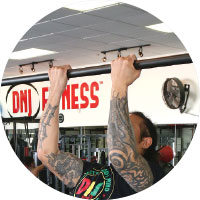 What Pretty Curls
What Pretty Curls
Underhand grip movements (like chin-ups) align your arms so that your biceps take more of the load like that of a curling movement, thus working them harder.
Standard Pull-ups/Chin-ups
Like the traditional push-up, there’s the standard pull-up/chin-up. Both follow the same movement of pulling one’s weight up and down; however, the primary difference is the grip taken, with pull-ups being overhand and chin-ups being under-hand. Pull-ups tend to be the more difficult of the two so most assume it’s better, but that’s not necessarily true. That has more to do with body mechanics. For every argument you can find on why the pull-up is better, you’ll find just as many favoring the chin-up. The grips can either be placed at mid-range (the most common), close, or wide.
1. Choose your grip beforehand, grasp the bar above you, dead hang your body so your elbows are straight, bend your legs, and cross your feet.
2. Look upward at the bar, begin pulling yourself up leading with your chest, shoulders back, drive your elbows to the floor, until they are bent as far as possible and your chin passes above the bar.
3. Lower yourself down to the starting position and repeat the steps.
Hang Out
2011 NCAA Division 1 National Wrestling Champion, Anthony Robles would hang for 30 minutes straight after he completed his workout. While it may not be working his back to the same extent as a pull-up/chin-up, it gave his arms (especially his forearms) extraordinary muscular endurance and a ridiculous grip!
Row, Row, Row Your… Body?
Body weight rows (AKA inverted rows) are another useful exercise to build up your strength. You’ll need a lower bar or something that is roughly arm’s length from the ground. Your same muscles will be worked; however, you’ll be performing the movement at a different angle. Think of it as a reverse push-up, but instead of pushing, you pull. It will teach you how to use your core area as well.
1. Lie flat on your back underneath the bar (or object) that is set just above where you can reach from the ground. Grasp the object with either an over or underhand grip. Contract your abdominal muscles so that your body will remain straight like a board.
2. Begin to pull yourself up to the bar while still contracting your abs. Don’t round your lower back or sag your hips.
3. Pull yourself up until your chest touches the object you are grasping and squeeze your shoulder blades together.
4. Lower yourself back down to the ground, keeping everything tight, so the length of your body remains straight, and then repeat the steps.
TIP: Want to make this more difficult? Simply elevate your feet on an object as illustrated.
Prescription: As a warm-up: 8-10 reps, as a workout: 3 sets of 8-15 reps.
No Lower Bar, No Problem
I’ve done this on the open back of a staircase and have seen someone use the underside of a dining room table.
Go Commando!
Easy my friends, it’s not that kind of party. Along with the earlier mentioned muscles being used, this unique pull-up variation hits the chest as well, while putting less stress on the shoulders.
1. Turn your body sideways so you’re able to look down the length of the bar. Grip the bar with your palms facing each other in a staggered position where they are next to each other.[/third_paragraph][third_paragraph]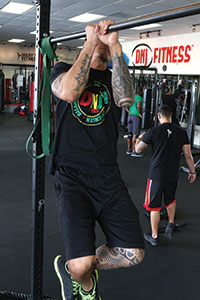
2. As you pull yourself up, move your head to one side to avoid hitting the bar and continue to pull until your chin reaches the bar. Alternate sides with each rep.
[/third_paragraph][third_paragraph]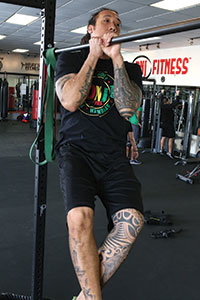
3. Once you complete a set, alternate your hands on each set to avoid muscle imbalances.[/third_paragraph][/row]
Prescription: As a warm-up: 8-10 reps, as a workout: 2 sets of 8-15 reps
Tough Guy?
If you ever get to the point that you don’t find any pull-up/chin-up variation tough enough then simply add to it for more of a challenge. Throwing your gi over the bar and performing a variety of hand grips will certainly challenge the strength of your hands and fingers. Scramble’s Grip Trainer, Origin’s OrangaHang and JitsGrips are all great alternatives to the gi that eliminate the excess material getting in your way and allow for more variety of grips. Using towels, two tennis balls (for Grappler Pull-ups), suspended Olympic rings (instead of a bar), ankle weights, weighted vests, and dip belts with additional weight will also step up the level difficulty.
Not There Just Yet?
If you have issues doing a pull-up/chin-up, another option would be to perform the movement with assistance through the use of a chair, plyometric box, exercise band, or having a partner help you.


